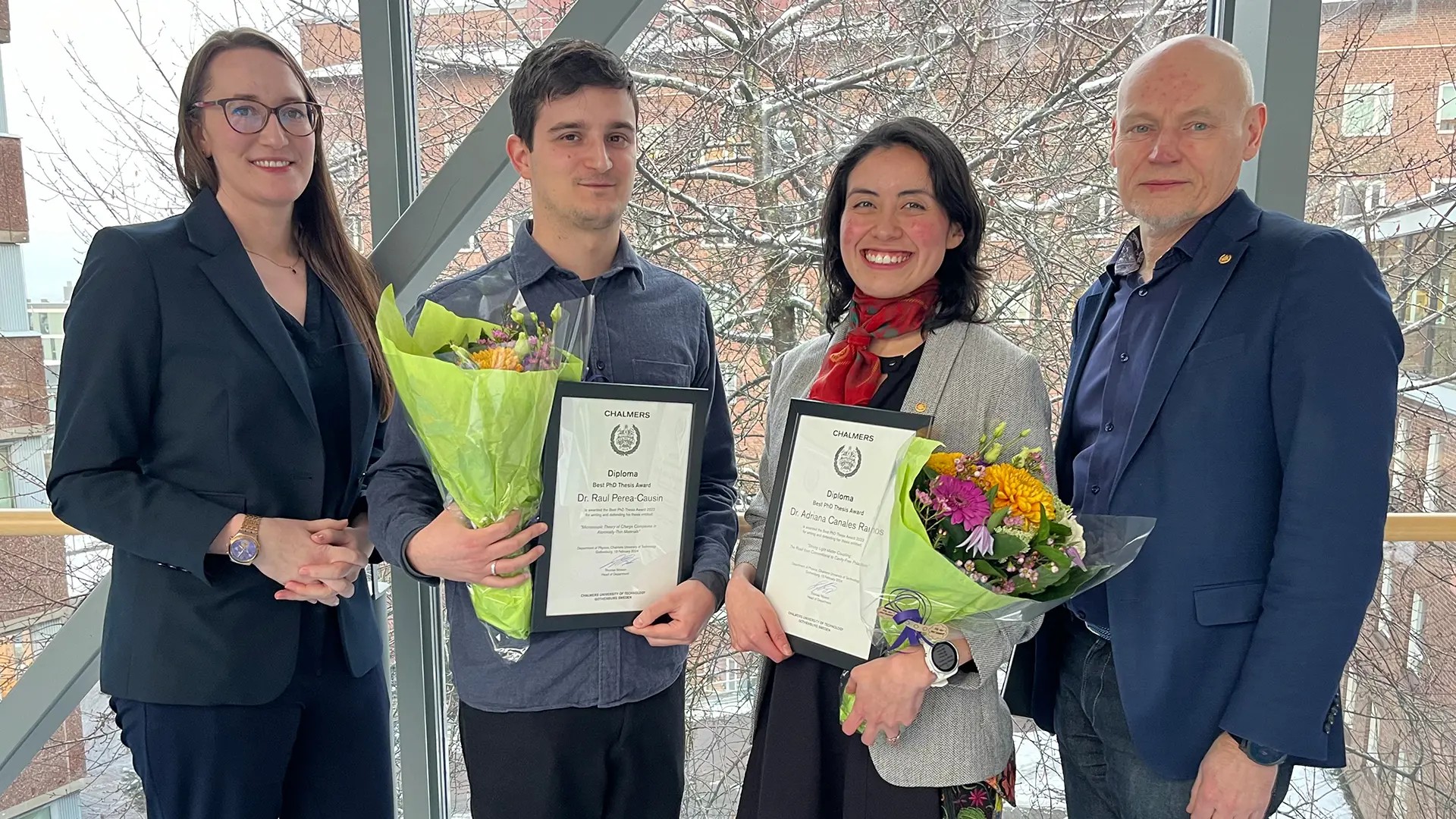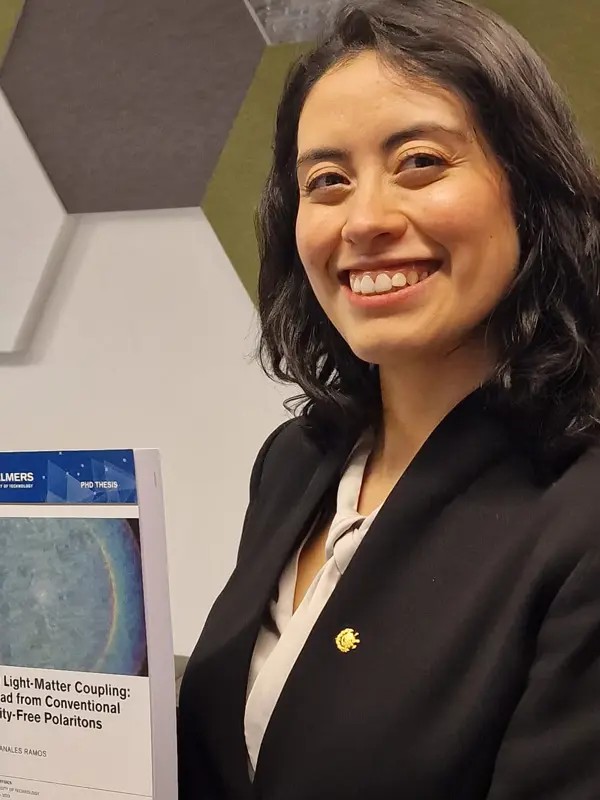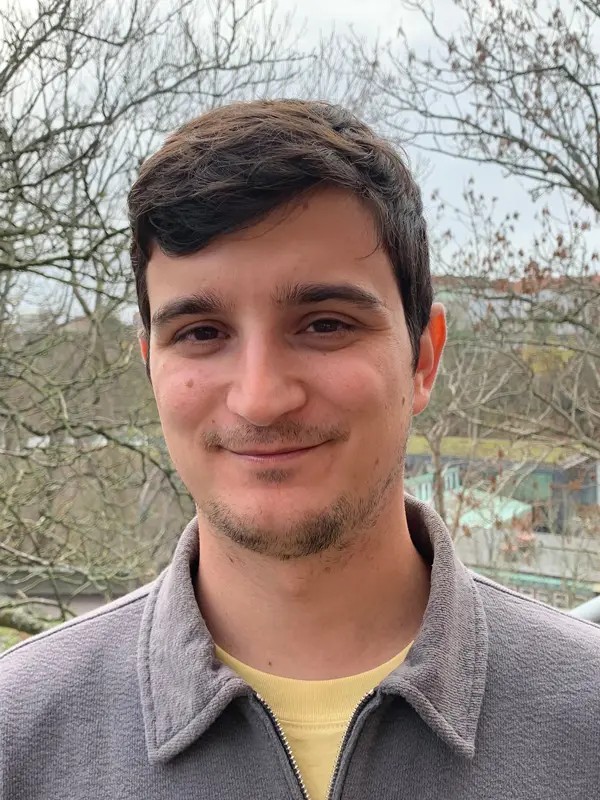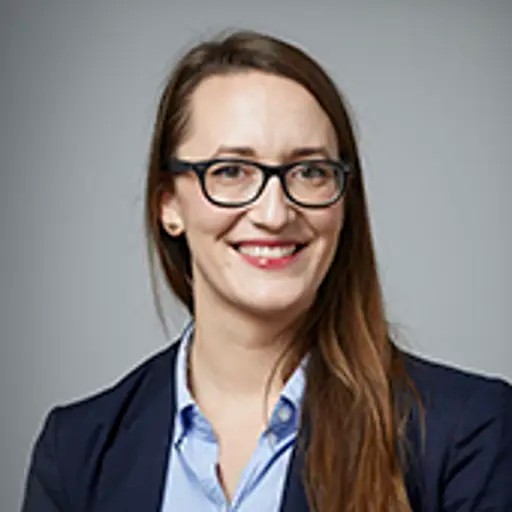
The interaction between light and matter, alongside studies of atomically thin materials, took centre stage in the doctoral theses honoured by the Department of Physics as the department's 2023 award for the best doctoral thesis was distributed. Adriana Canales Ramos and Raul Perea-Causin were the two delighted recipients of the award.
The two newly qualified physics doctors Adriana Canales Ramos and Raul Perea-Causin were awarded for their doctoral theses titled Strong Light-Matter Coupling: the Road from Conventional to Cavity-Free Polaritons, respectively Microscopic Theory of Charge Complexes in Atomically-Thin Materials.
Here, they provide further insight into their research and share their top tips for writing a winning thesis.

Shows that polaritons are more common than previously thought
Polaritons are a hybrid of light and matter, and they are in focus in Adriana Canales Ramos’ doctoral thesis.
“People have studied the funny properties of polaritons using complex samples and setups for a long time. My thesis focuses on showing that obtaining polaritons is easier than previously thought,” she says.
We can perceive and explore the world around us because of the way light interacts with matter. In most interactions, light doesn’t change the properties of matter, and they are called weak interactions. Adriana Canales Ramos’ thesis focuses on the strong regime when light and matter hybridize. Then, describing their properties requires a new quasiparticle, the polariton. Those are something that Adriana Canales Ramos have fabricated. This can be complicated, since you first need extremely good light resonators, or cavities, that trap light long enough to interact with the material strongly.
“Like many, I started fabricating samples in our cleanroom with simple gold mirrors to form microcavities. Then we noticed that gold nanoflakes in colloids self-assemble and create microcavities resonating in the visible! They are perfect to be strongly coupled to some 2D materials. These self-assembled microcavities not only allowed us to simplify the fabrication of the samples but also to tune polaritonic properties passively and dynamically, a challenging task in many other setups,” she says.
Polaritons may occur in clouds
Later on, Adriana Canales Ramos theoretically showed that some materials are shaped in geometries that allow them to sustain optical modes that trap light long enough to interact strongly with light without requiring external cavities. These materials get a cavity for free and “self-hybridize,” creating polaritons without intricate fabrication. Her last works focused on measuring these cavity-free self-hybridized polaritons in 2D materials and water droplets.
“My final work shows that polaritons are more common than we thought because they can even occur naturally in water droplets in clouds!”
Even though Adriana Canales Ramos main field of research during her doctoral years was around polaritons, she also had the opportunity to work on different projects that contributed to various fields, like Casimir physics, Mie resonances, and perfect absorbers. She found it to be a bit of a challenge to summarize that work in a cohesive way in the thesis.
“Some of those findings couldn’t be spotlighted in the thesis due to space limitations. However, I am very happy with the final thesis as it allowed me to convey my main messages more clearly.
On the other hand, it was easy and emotional to write the acknowledgments. Despite the challenges of a PhD, I had amazing mentors and colleagues, so it was easy to write how wonderful they were and how grateful I am for having crossed paths with them.”
“It feels wonderful to receive this award! I am extremely happy, and I feel grateful and proud. I poured a lot of enthusiasm into writing my thesis. Seeing that other people enjoyed it and found it interesting brings me pure joy.”
Figure out the main messages first
If she were to give advice to other PhD students about to write a thesis of their own, it would be to try to figure out the main messages before the writing process, as this will make it easier to find the storyline.
“Then, the rest of the thesis should give context and results to support those messages. You will be way faster at writing if you have clarity. In addition to practical advice, at the end of your PhD, you will have acquired extensive knowledge about your research field. Some of this knowledge may be unique to you and a few others. Take this chance to highlight your key findings and express your opinions. Write something that you would find interesting to read. Finally, try to enjoy the writing process as much as possible. It will be finished faster than expected.”
Adriana Canales Ramos has now started a position as a Photonics Applications Engineer at Thorlabs Sweden. She empathizes that her doctoral years has taught her a lot of things, such as developing her skills in management, communication, collaboration and leadership.
“I developed those skills working on my research, in student councils, teaching, and in some courses, including Genie's workshops. I have learned to effectively communicate complex concepts to different audiences through teaching and attending conferences. I improved my writing and visual communication skills by writing papers with informative and beautiful figures. I am now more confident in learning new technical skills and questioning established knowledge creatively. Additionally, I have become much better at prioritizing tasks, organizing my daily routine, and understanding my and others' working styles. I discovered that I am good at networking and enjoy collaborating. Although my projects sometimes felt like solo tasks, I had numerous discussions and even joined other projects for the fun of collaborating. Together, we can do better. I bring all that to my future endeavours and am grateful for the lessons I learned at Chalmers.”
The prize committee's motivation:
Adriana presented a thesis about strong light-matter interaction in the form of polaritons. We were impressed by the quality, depth and breadth of research. In addition to original and fascinating experimental work, Adriana performed theoretical projects with depth and understanding which are rare in such combined theses. Within her thesis, she presented an extraordinary personal take and reflection on what it is to become a PhD. The committee read her work with high interest and it was a pleasure to read thanks to the pedagogy, clean context, and cohesiveness.

Has contributed to a better understanding of the properties of atomically thin semiconductors
Semiconductors, which can be tuned to be electrical conductors or insulators, play a central role in the electronic devices that we use daily. When their thickness is reduced to a single atomic layer, these materials acquire exceptional properties that could increase the efficiency of existing devices or even lead to completely new technologies. For his thesis, Raul Perea-Causin has investigated a class of semiconducting materials that are just a few atoms thick.
“Overall, my work has contributed to a better understanding of the optical and electronic properties of atomically thin semiconductors,” says Raul Perea-Causin, and then shares the details of what he has studied in his doctoral thesis:
“While having a ridiculously small thickness – they’re one hundred thousand times thinner than a sheet of paper – these materials can for example absorb up to 20 percent of the incident light. This is a consequence of a fundamental quantum effect: the incident light excites electrons into states with higher energy, and these electrons are attracted to the “holes” that they leave behind because they have opposite electric charge. As a result, electrons and holes bind together into pairs called excitons. The efficient light absorption is a direct consequence of the strong binding of these particles,”
Quantum mechanical models
In the first part of the thesis, he built quantum mechanical models to understand the mechanisms behind the formation and propagation of excitons as well as their dissociation into unbound electrons and holes.
“In particular, my work was essential to explain the experimental observation of the formation dynamics of so-called dark excitons, and their propagation and evolution into a halo shape. During the later stages of my research, I investigated trions; exciton-electron compounds that are formed by adding electrons to the system,” Raul Perea-Causin.
In this case, he suggested how the propagation of trions can be enhanced by utilizing their quantum nature, and showed that their internal structure significantly influences the stability and the light emission of these particles.
Raul Perea-Causin will now continue his scientific career at Stockholm University, where he will investigate a different aspect of atomically thin materials related to their quantum topology.
“During my doctoral studies I have become a confident and independent researcher, which is exactly what I need to be to face the new challenges that await me!”
When asked how it feels to be awarded for his thesis, he replies:
“It feels great, of course! It is very rewarding to be recognized for my hard work, and it is surely a morale boost to see that the committee considered my research to be of the highest quality.”
A clear red thread
When writing the thesis, he found that coming up with the structure of the thesis was easy. The different projects he was involved in were connected in a very natural way, therefore the red thread of the thesis was clear before he started writing.
“The more difficult part was to find the balance between covering the important details and keeping the text concise and easy to follow. I hope I managed to do that. My best advice to others who are about to write a thesis of their own is to plan it well. Decide the title and structure of the thesis early on, and then plan how long it will take to write each chapter. Make sure to leave enough free time before the deadline to go through your text again and to compensate for possible delays. Also, don’t get stuck on details and focus on finishing each chapter even if you are unhappy with the result — you will find ways to improve it once you have a complete text.”
The prize committee's motivation:
Raul presented a theoretical work on charge complexes, like excitons or trions, in atomically thin materials. We were impressed by the quality and quantity of the research and the broadness and depth of Raul's thesis. The thesis was extremely clear and easy to read even for people outside the field. Raul's writing, concise and pedagogical, makes it easy to follow the path from the necessary theory, through how the problems are solved, to the final results and their significance.
About the Best Thesis Award
- The Best Thesis Award was founded in 2013, as one among several initiatives at the Department of Physics, to maintain and improve the research quality, as well as to show appreciation for the PhD students' hard work.
- The management of the department also hopes that this award can help doctoral students receive an extra boost in their careers after the defence. These particular theses can serve as good examples for doctoral students in the early stages of their own thesis writing. Besides the honour, the award consists of a diploma and a monetary prize of SEK 10.000.
- Members of the prize committee for the 2023 award were: Dinko Charakov, Magnus Hörnqvist Colliander, Matthias Geilhufe, Hana Jungova, Julia Maibach, Paolo Vinai and Julia Wiktor (chair).
Chair of the prize committee
- Associate Professor, Condensed Matter and Materials Theory, Physics
